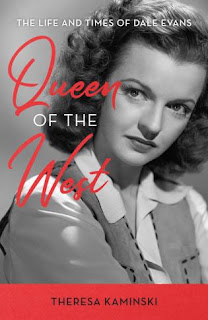
Kaminski applied the “Page 99 Test” to her new book, Queen of the West: The Life and Times of Dale Evans, and reported the following:
Any human reader or electronic browser opening up Queen of the West to page 99 would find Dale Evans living through the spring and summer of 1945. As World War II drew to a close, she experienced big changes in her personal and professional lives. Dale’s home life was breaking up. Her marriage to musician/composer R. Dale Butts was on the rocks. Her son, Tom, graduated from high school that spring, and he would move out in the fall to begin college. She was pleased and proud about her son’s accomplishments.Visit Theresa Kaminski's website.
But Dale Evans was less pleased with her career. She had left Republic Pictures, where she had been on contract since 1943, because Herbert Yates, the studio head, refused to cast her in anything but Roy Rogers westerns. She appreciated how those movies helped boost her star power but remained convinced she could never achieve the leading lady status she sought by appearing in “horse pictures.” Dale intended to become a leading lady, and she was planning a move to a different studio where she believed that could happen. But it was happening too slowly.
A passage from page 99:To underscore her determination to break away from westerns, Dale gave an in-depth interview to Maxine Garrison, a feature writer for the Pittsburgh Press. Dale knew she risked making waves with Republic and with her fans, but she wanted to clarify her feelings about her career. The story included a photo of the ‘Queen of the Westerns’ clad in a two-piece swimsuit and a pair of high heels. It ran on August 9, the day the atomic bombing of Nagasaki dominated American headlines.Queen of the West brilliantly passes the Page 99 Test. It illuminates a central struggle Dale Evans faced, one many women still confront today: How to blend a happy family life with a fulfilling career. This is a theme I explore throughout the biography. In the spring and summer of 1945, Dale knew she was at a crossroads both personally and professionally. Her marriage was not going to last, and she always envisioned herself in a happy marriage with a loving husband. Her only child was about to leave home, and she wasn’t quite sure how she felt about no longer having someone to mother.
Dale took a big step with her movie career that summer and declined to sign a new annual contract with Republic Pictures. RKO wanted her to star with comedian/dancer Eddie Cantor in Show Business Out West, a “sophisticated” musical comedy. She believed this would result in a long-term contract with RKO. Until the details were finalized, Dale signed single-picture deals to appear in a few Roy Rogers movies. She needed to keep working, to keep her face up on the silver screen. But the longer RKO kept her waiting, the more uneasy she became.
Another of the book’s themes also surfaces on page 99. Dale Evans exercised as much control as she could over her image and her path to celebrity. The interview she gave with Maxine Garrison was likely well-planned, with both the choice of journalist and the carefully considered responses. (Several years later, Garrison would be hired as assistant public relations director for Roy Rogers/Dale Evans Enterprises.) Dale appreciated her “Queen of the Westerns” (later changed to “Queen of the West”) nickname, but she didn’t want it to become the dominant image of her career. The remainder of the book traces how she handled that challenge.
Coffee with a Canine: Theresa Kaminski & Hugo.
The Page 99 Test: Angels of the Underground.
The Page 99 Test: Dr. Mary Walker's Civil War.
--Marshal Zeringue



